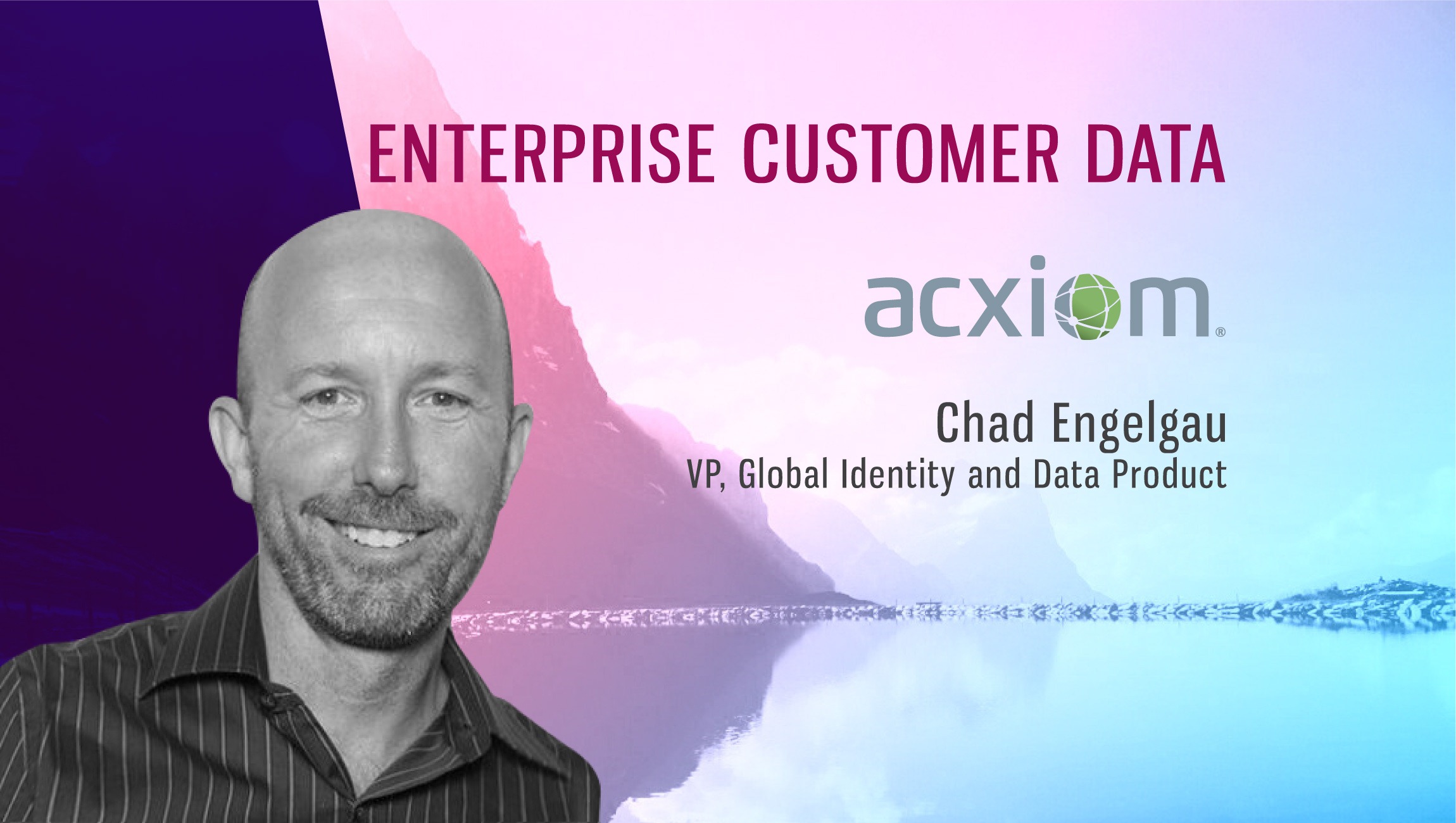Chad Engelgau
VP, Global Identity and Data Product Management, Acxiom
Enterprise Customer Data is a critical resource in this age of data-driven marketing. Chad Engelgau, VP, Global Identity and Data Product Management, Acxiom, spoke to us about the challenges in centralizing data and how enterprise customer data could be leveraged to deliver personalization at scale.
Html code here! Replace this with any non empty text and that's it.
Tell us about your role at Acxiom and the team/technology you handle.
I am the VP of Product and Marketing at Acxiom Marketing Services. My team sets the strategy and product roadmap for Acxiom’s omnichannel identity and data products as well as the marketing solutions portfolio. I also own the Product Marketing function supporting Sales and Demand Gen.
What is the state of Enterprise Customer Data in 2018?
Innovation has far outpaced consolidation in the martech and adtech space, a landscape of over 6,000 technologies and growing, negatively impacting a company’s ability to manage, unify, analyze and reactivate its data to create unique consumer experiences and improved business outcomes. A survey by Adestra and Ascend2 found nearly half of marketing influencers and research subscribers find data management to be challenging. This has caused many marketers to have five or more marketing stacks that are disconnected, leaving data puddles everywhere that impact their brand’s ability to deliver truly relevant experiences.
In a February 2018 survey by the Winterberry Group and IAB, marketing professionals named the ability to centralize storage of all data assets and centralize ownership of related technology among the most important for deriving value from their company’s future use of data. As part of this movement, we are seeing leading marketers focus on creating a unified data layer that connects all data at the customer level to power their integrated marketing ecosystem, enabling them to capture all of their marketing insights and consumer touchpoints, normalize and fuel their analytics, better control their data assets and activate more powerful personalized experiences.
What does your product roadmap for 2018-2020 look like?
We believe there are three fundamental investments required to overcome these above issues. To unify all the data puddles that exist across the enterprise and their tech stacks; marketers must consolidate and resolve their consumer insights into a common identity space in order to create the right foundation that resolves to real-people before building out functional next-gen solutions designed to engage people. The brands can focus on adding all the rich, contextual insights they have across channels to better analyze and then active those audiences across campaigns and personalization initiatives.
To accomplish this, we use machine learning and AI across our broad set of offerings and service lines to expedite the data ingestion across known and anonymous sources, enhancing the identity resolution processes and graph building process, as well as adding new model building and scoring algorithms. Specific AI and ML toolsets embedded across the marketing stack provide marketers with more insights, quicker than ever before. Gleaning the maximum benefits of these types of tools relies on having unified, “good” data— a critical pillar of our approach.
Two, we know that managing consumer data requires greater controls due to GDPR and other pending legislation in the US. We are extending our Privacy By Design framework, workflows and toolsets to help marketers ethically manage the data assets they control.
Finally, extending our unified data layer framework to seamlessly support an expansive set of marketing applications beyond our current partnerships with Adobe and Redpoint—providing robust integration services with a broader set of DMP, tag management and CDP providers. This will give each marketer the flexibility needed to build and integrate best of breed marketing apps into their unified data layer.
How can companies better unite their enterprise customer data for better personalization?
The first step is by creating a unified data layer across known and anonymous assets, using a consistent set of data to fuel insights in those domains and then activating those across a common, people-based ID space into dynamic creative platforms and personalization engines on their own websites and properties. Mapping those customer journeys and applying those proper “next-best action/offer” back to the ecosystem is what we see working best today.
How does the enterprise customer data fit into Acxiom’s email and cross-channel marketing platform?
Acxiom’s key differentiators span accuracy, scale, ethical data use, and exceptional service. Together, these attributes breed an omnichannel data asset capable of being leveraged in any email or cross-channel platform that doesn’t lock a client into Acxiom’s platform alone. According to Conductor, 43 percent of marketers are using between 6 and 10 marketing technologies. This is further supported by a Walker Sands/Chief Marketing Technologist survey that found that about one in 10 marketers who had integrated best-of-breed architecture were using at least 10 marketing tech tools. Case in point, marketers need flexible offerings. We power that by engaging or fuelling any platform that a marketer wants to use.
To what extent can digital analytics platforms further boost ROI from their tech stack using Acxiom?
Digital analytics platforms are great tools that give marketers insight into campaign performance and really bring the data to life. Anchoring those in people-based, omnichannel identity resolution solutions like LiveRamp’s IdentityLink for Analytics is a crucial first step to ensure you are seamlessly tying together all anonymous and known interactions to real people and households. Failing to do this puts you at risk of impacting the fidelity of your measurement offerings.
Also, it is critical to ensure you have a complete measurement strategy that brings together both digital and offline data to truly measure the incremental impact of your marketing efforts.
How do you work with Data Science and AI/ML to improve your data management platform?
We use machine learning and AI across our service lines to expedite model building and scoring, file ingestion and identification and identity resolution, and are investing more research and dollars into extending these capabilities. AI/ML is critical to expedite the analytics process and scale an organizations ability to ingest, manage and gain insights from the tsunami of data they face in today’s environment.
Our unified data layer-powered analytic environments provide embedded machine learning protocols and tools that offer both Acxiom and our clients’ analytic teams robust analytic environments to drive powerful analytics.
Thanks for chatting with us, Chad.
Stay tuned for more insights on marketing technologies. To participate in our Tech Bytes program, email us at news@martechseries-67ee47.ingress-bonde.easywp.com











